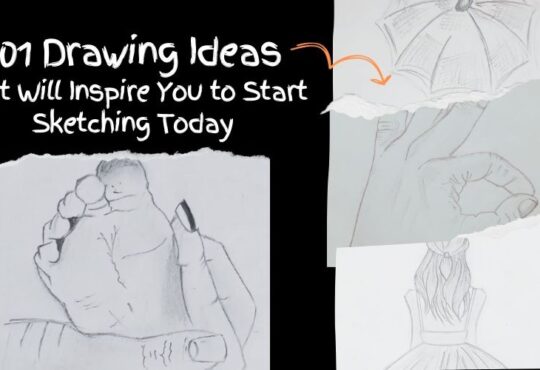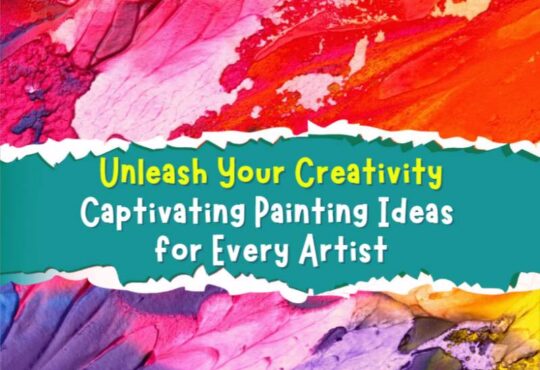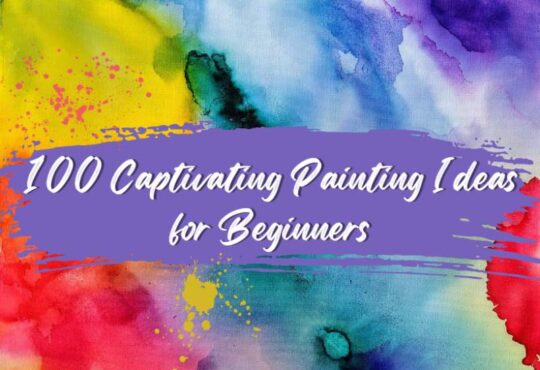5 Easy DIY Art Projects for Beginners
Are you a beginner artist looking to explore your creative side? Look no further! In this article, we will guide you through five easy DIY art projects that will help you unleash your creativity. Whether you’re an aspiring painter or a craft enthusiast, these projects are perfect for beginners and require minimal supplies.
From beautiful watercolor landscapes to vibrant abstract designs, these art projects will allow you to experiment with different techniques and express your unique artistic style. Not only will you have fun during the creative process, but you’ll also have beautiful pieces of art to display or give as heartfelt gifts.
With step-by-step instructions and helpful tips, you’ll gain the confidence to dive into the world of art and create something truly amazing. So grab your brushes, paints, and a sense of adventure, and get ready to unleash your creativity with these easy DIY art projects. Get ready to discover the artist within you!
Getting started: Basic art supplies and tools
Before we dive into the exciting world of DIY art projects, it’s important to have the right tools and supplies on hand. As a beginner, you may not have an extensive collection of art materials, but there are a few essentials that you’ll need to get started.
Firstly, you’ll need a set of brushes. Opt for a variety of brush sizes to allow for different strokes and effects. Next, invest in a set of paints that suit your project preferences. Watercolor paints are great for delicate washes, while acrylic paints offer vibrant and bold colors. Additionally, you’ll need a palette for mixing colors, a water container to clean your brushes, and a set of canvases or paper to work on.
Remember, art is all about experimentation, so don’t be afraid to try different materials and tools as you progress on your artistic journey. Now that you have your supplies ready, let’s jump into the first art project.
Project 1: Watercolor painting for beginners
Watercolor painting is a versatile and forgiving medium that is perfect for beginners. It allows you to create beautiful, translucent washes of color and capture the essence of a subject with ease. To get started with watercolor painting, follow these simple steps:
1. Choose a reference photo or a simple object to paint. It could be a landscape, a flower, or even a still life arrangement.
2. Sketch the basic outlines of your subject lightly on your paper or canvas using a pencil.
3. Wet your brush and dip it into the desired color. Apply the color to your paper using gentle brushstrokes, gradually building up layers and adding more water for lighter tones.
4. Experiment with different brush techniques like wet-on-wet, wet-on-dry, and dry brush to create interesting effects.
5. Once you’re satisfied with your painting, let it dry completely before adding any details or final touches.
Watercolor painting is all about embracing the fluidity of the medium and allowing happy accidents to happen. Don’t be afraid to make mistakes and learn from them. With practice, you’ll become more confident in your skills and create beautiful watercolor artworks.
Project 2: Collage art using recycled materials
Collage art is a fantastic way to repurpose old magazines, newspapers, and other discarded materials into a unique piece of art. It allows you to explore different textures, colors, and patterns while creating a visually striking composition. Here’s how you can create a collage art piece using recycled materials:
1. Collect a variety of materials such as old magazines, newspapers, fabric scraps, and colored paper. Cut or tear them into different shapes and sizes.
2. Start with a base material like a canvas or thick paper. Apply a layer of adhesive, such as glue or Mod Podge, onto the surface.
3. Begin arranging the cut-out materials on the base, overlapping and layering them to create a visually interesting composition.
4. Experiment with different textures and patterns by tearing or cutting the materials in various ways.
5. Once you’re satisfied with the arrangement, apply another layer of adhesive over the collage to secure the pieces in place.
6. Allow the collage to dry completely before adding any additional embellishments or details.
Collage art is a great way to unleash your creativity and create something unique using everyday materials. Let your imagination run wild and see where it takes you.
Project 3: Acrylic pouring techniques
Acrylic pouring is a trendy and mesmerizing art technique that involves pouring different colors of acrylic paint onto a canvas to create abstract patterns and designs. The beauty of this technique lies in its unpredictability, as the colors blend and interact with each other to form stunning compositions. Here’s how you can try acrylic pouring:
1. Prepare your workspace by covering it with a plastic sheet or drop cloth to protect it from any spills or drips.
2. Mix your acrylic paint colors in separate cups, adding pouring medium or water to achieve a more fluid consistency.
3. Pour each color onto the canvas, either by layering them in a cup or pouring them directly onto the canvas.
4. Tilt the canvas gently to allow the colors to flow and blend together. Experiment with different tilting angles to create different effects.
5. Use a palette knife or a heat gun to manipulate the paint and create additional patterns or textures.
Acrylic pouring is a fun and experimental art technique that allows you to let go of control and embrace the unpredictable nature of the medium. Each pour will be unique, and you’ll be amazed at the beautiful patterns that emerge.
Project 4: Hand-lettering and calligraphy
Hand-lettering and calligraphy are art forms that focus on creating beautiful and stylized letters and words. They can be used to enhance greeting cards, create personalized artworks, or simply add a touch of elegance to your everyday writing. Here’s how you can get started with hand-lettering and calligraphy:
1. Choose a writing utensil that suits your style and preference. Popular choices include brush pens, dip pens, and markers.
2. Practice basic letterforms and strokes to get comfortable with the movement and pressure required for hand-lettering.
3. Experiment with different lettering styles, such as modern calligraphy, vintage lettering, or bold block letters.
4. Once you feel confident with your lettering skills, start creating small projects like inspirational quotes, personalized cards, or even your own hand-lettered journal.
Remember, hand-lettering and calligraphy require patience and practice. Don’t be discouraged if your initial attempts don’t turn out as expected. Keep practicing, and soon you’ll be creating beautiful lettering pieces.
Project 5: DIY embroidery hoop art
Embroidery hoop art is a traditional craft that has gained popularity in recent years. It allows you to create intricate designs using colorful threads and a simple embroidery hoop. Here’s how you can try your hand at embroidery hoop art:
1. Start by selecting a fabric that will fit within your embroidery hoop. Cotton or linen fabrics work best for embroidery.
2. Stretch the fabric tightly over the inner ring of the embroidery hoop and secure it in place by tightening the outer ring.
3. Choose an embroidery pattern or design that you would like to recreate. You can find patterns online or create your own.
4. Thread your needle with the desired color of embroidery floss and start stitching according to your chosen pattern.
5. Experiment with different stitch techniques like satin stitch, backstitch, or French knots to add texture and depth to your design.
6. Once you’ve completed your embroidery, trim any excess fabric and secure the back with a piece of felt or another fabric for a neat finish.
Embroidery hoop art allows you to create beautiful and personalized pieces that can be displayed on your walls or given as heartfelt gifts. Let your imagination guide you as you experiment with different colors and designs.
Tips for beginners: Overcoming creative blocks and finding inspiration
As a beginner artist, it’s common to experience creative blocks or feel uninspired at times. Here are a few tips to help you overcome those challenges and find inspiration:
1. Take breaks: Sometimes, stepping away from your project and taking a break can help refresh your mind and spark new ideas. Go for a walk, read a book, or engage in activities, or participate in pursuits that ignite your creativity and passion.
2. Experiment with different mediums: Don’t limit yourself to just one art medium. Try your hand at painting, drawing, pottery, or any other form of art that catches your interest. Exploring different mediums can help you discover new techniques and find what truly resonates with you.
3. Join art communities: Participating in local art events or joining online art communities can provide you with a supportive network of fellow artists. Sharing your work, receiving feedback, and seeing other artists’ creations can be incredibly motivating and inspiring.
4. Look for inspiration in everyday life: Inspiration can be found everywhere – in nature, architecture, music, or even in the people around you. Keep your eyes open and take note of the things that captivate your attention.
Showcasing your art: Sharing on social media and participating in local art events
Once you’ve created your masterpieces, it’s time to showcase them to the world. Sharing your art on social media platforms and participating in local art events can help you gain exposure, connect with other artists, and receive valuable feedback. Here are a few tips to help you showcase your art effectively:
1. Create a digital portfolio: Build a website or utilize social media platforms like Instagram or Pinterest to showcase your art. Organize your work into different categories and provide descriptions and stories behind each piece.
2. Engage with your audience: Respond to comments, messages, and inquiries from your followers or potential buyers. Building relationships with your audience can lead to collaborations, commissions, or even sales.
3. Participate in local art events: Look for art exhibitions, craft fairs, or open studios in your area where you can display and sell your artwork. These events provide opportunities to network with other artists and art enthusiasts.
4. Collaborate with other artists: Collaborations with other artists can help you expand your creative horizons and reach new audiences. Consider partnering with artists from different mediums or styles to create unique and exciting projects.
Conclusion: Embracing the journey of creativity
Embarking on a creative journey as a beginner artist is an exciting and fulfilling endeavor. Through the five easy DIY art projects we’ve explored, you’ve gained valuable insight into different art techniques and mediums. Remember, the most important aspect of art is to enjoy the process and embrace your own unique style.
Unleashing your creativity is a lifelong journey that involves continuous learning, exploration, and self-expression. Don’t be afraid to take risks, make mistakes, and learn fearlessly. Allow your art to evolve and grow as you gain more experience and confidence.
So, grab your brushes, paints, and a sense of adventure, and get ready to unleash your creativity with these easy DIY art projects. Discover the artist within you and let your imagination soar. Happy creating!








